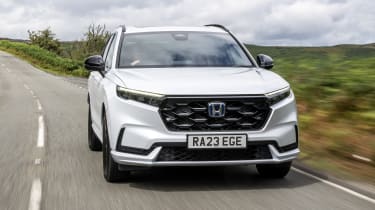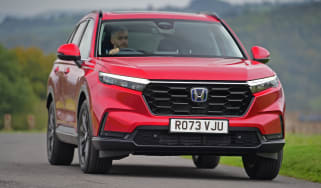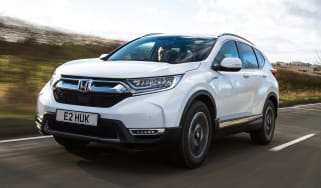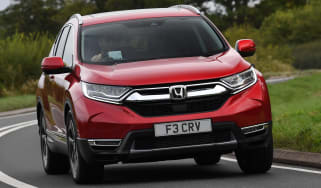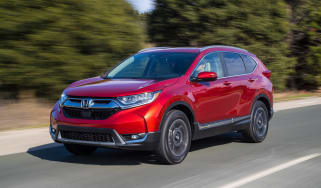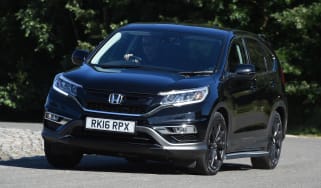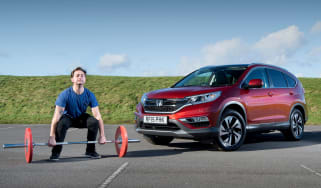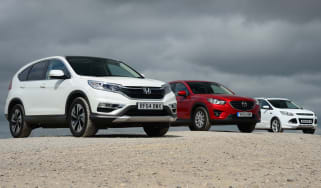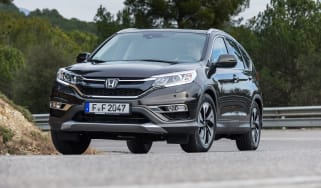Honda CR-V review
Roomy, well-equipped and stuffed with safety technology, the Honda CR-V is a fine choice for families, albeit a pricey one

Our opinion on the Honda CR-V
Does the Honda CR-V still stand for ‘Compact Runabout Vehicle? Well, at over 4.7 meters in length for this sixth-generation version, we wouldn’t say so. Perhaps ‘Comfortable Runabout Vehicle’? Again, we’d be inclined to say you can find several rivals that are more comfortable.
However, the CR-V is a spacious, well-equipped SUV that’s also packed with safety technology to keep you and your loved ones safe. Mind you, it should come stacked with equipment, considering its premium pricing.
About the Honda CR-V
The CR-V has been a part of the Honda lineup since the late ‘90s when it was the brand’s only SUV, and it competed with rivals like the Land Rover Freelander and Toyota RAV4. Today, the CR-V sits above the smaller Honda HR-V and Honda ZR-V as the largest SUV in the Japanese manufacturer's lineup.
Pricing for the CR-V is pretty punchy because that puts it in the realm of some excellent premium SUV choices. Some of which have the additional flexibility of seven seats, which is impossible with the hybrid-only UK CR-V range because the batteries and the associated hybrid gubbins take up the space where the third row would go. Seven seats are available in petrol-only versions of CR-V sold in other countries, but we won’t get that option in the UK because the petrol is too thirsty for our tastes.
Honda CR-V pricing and latest deals
Pricing for the latest Honda CR-V starts at just under £47,500 for the e:HEV Elegance hybrid, rising to around £50,500 for the e:HEV Advance. The plug-in hybrid comes in at around £50,000.
Used - available now
If you're interested in getting yourself a Honda CR-V, we can help. Configure your ideal Honda CR-V now to get top offers from local dealers, check out the latest Honda CR-V leasing deals, or search for used Honda CR-V models with our Buy A Car service. You can even sell your existing car for a great price with Auto Express Sell My Car.
Performance & driving experience
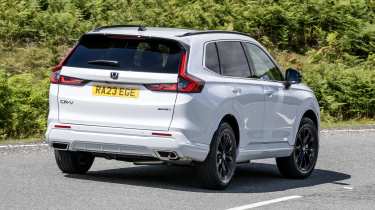
| Pros |
|
| Cons |
|
Both versions of the Honda CR-V use a similar 2.0-litre Atkinson cycle engine/electric motor combination used to power the current Honda Civic and Honda ZR-V.
Driving the Honda e:HEV hybrid is straightforward, even if a lot happens behind the scenes. The 2.0-litre engine primarily works as a generator of electricity that powers the electric motors that drive the wheels. The upshot is that you get an electric car's smooth, jerk-free progress. Any electricity not being used to drive the CR-V charges a modest 1.06kWh battery, which stores enough power to allow you to drive for short distances at low speeds without using the engine.
At higher speeds, the battery provides a power boost when you need to accelerate quickly, such as when overtaking. It doesn’t have the hesitancy we’ve experienced in the Mazda CX-60 or Austral when asking for more power.
One point worth raising is that the CR-V, like most Hondas, doesn’t make it particularly easy to switch off the speed limit warning, which is a feature necessary for all new cars to achieve a good NCAP safety rating. Unlike the lane departure warning system that can be disabled in the digital instrument cluster at any time, you have to go into the Driver Assistance settings within the central touchscreen to turn off the speed limit warning before you set off, because that menu is greyed out once the car is in ‘Drive’. We prefer the way Renault addresses this issue by allowing you to customise your preferred safety assistance technology in a ‘My Perso’ setting, which can be easily recalled by pressing a physical button located behind the steering wheel on the right.
Performance, 0-60mph acceleration and top speed
With only 181bhp on tap in a reasonably heavy SUV, the CR-V doesn’t feel particularly rapid. The 0-62mph for both the e:HEV hybrid and PHEV models is 9.4 seconds, which is best described as ‘adequate’ rather than thrilling. It’s marginally slower than a Kuga hybrid, and offers nowhere near the lightning performance of a genuine electric car, such as the Tesla Model Y.
At motorway speeds, the engine is connected to the wheels in a fixed gear ratio. Think of it like putting a regular petrol or diesel car into top gear, with the benefit of this being that, unlike a Lexus NX and Toyota RAV4 with e-CVT systems, the engine revs don’t soar when you need to accelerate, making the Honda hybrid system much more refined.
The PHEV model features a larger 17.7kWh battery, which can power the CR-V for up to 49.1 miles on electricity alone. Once depleted, it behaves like the regular hybrid, without the dramatic drop-off in efficiency we’ve experienced in other plug-in hybrid SUVs.
Town driving, visibility and parking
Around town, the CR-V is supremely quiet when running in its electric mode. The e:HEV hybrid can only manage this for short periods due to its small battery, whereas the e:PHEV plug-in hybrid can travel further without using the engine. It can also use its electric mode at higher speeds due to its greater battery capacity.
The CR-V's regenerative braking system differs from that of several hybrid-powered rivals in that you can adjust the rate of deceleration when lifting off the accelerator using paddles located behind the steering wheel. The system isn’t strong enough for one-pedal driving, like you’ll find in a Nissan equipped with an e-Pedal system, but you’ll still get some satisfaction from using the regen’ to slow you down for a roundabout or help you filter in traffic without needing the brakes, plus it has the benefit of putting some energy back into the battery, helping to boost your overall fuel efficiency. The brakes themselves are strong, with a reassuring pedal feel that’s easy to judge – a key quality in allowing you to come to a smooth stop.
The ride deals with bigger bumps reasonably well, but the CR-V doesn’t smooth out smaller imperfections as well as the Land Rover Discovery Sport does, and tends to fidget over rough sections of road. That’s disappointing for a car that comes with relatively small 18-inch wheels with a generous tyre sidewall as standard, whereas the Discovery Sport is much more composed on massive 20-inch wheels.
B-road driving and handling
You might argue that power and fun aren’t relevant qualities for an SUV like the Honda CR-V, but rivals like the BMW X3 or Ford Kuga offer a more engaging drive. We were disappointed that the same nose-heavy feeling we experienced in the smaller Honda ZR-V persists here, with the limit of grip from the front being lower than we’d like in a large SUV. It’s especially at odds with the heavier-than-expected steering, which, in typical fashion these days, doesn’t offer much feedback as to when the CR-V starts to lose purchase on the Tarmac.
It’s best to drive it in a relaxed manner, which the CR-V is happy to do. Ride comfort is reasonable, and the CR-V doesn’t feel unwieldy on the road despite the increased size. Body lean in the bends is well-managed, but on the whole, there are sharper-handling SUVs out there. Matters aren’t improved in any of the four drive modes (or five modes in the e:PHEV version) you select: the only difference we noted was the augmented engine sound of a Honda Civic Type R being played through the speakers when ‘Sport’ mode was engaged.
Motorway driving and long-distance comfort
At motorway speeds, we found more road noise over rougher sections of Tarmac than we’d like in a premium SUV, along with some wind noise that you need to turn the stereo up in order to drown out. The engine can kick up more of a fuss when stretched than a Renault Austral, but it dies away into the background once up to speed. In the regular hybrid, it can even switch the engine off for short periods on level ground or heading downhill.
“One feature that came in very useful was the camera feed from the left-hand door mirror. Colleagues were quite dismissive of the tech in our road test, but the view displayed on the touchscreen – complete with red and orange marker bars to show how far you’re clear of cars behind – proved to be a real boon when executing lane-changes on a busy autobahn in wet or gloomy conditions.” – Chris Rosamond, former current affairs and features editor
| Model | Power | 0-60mph | Top speed |
| e:HEV Elegance AWD | 182bhp | 9.4s | 116mph |
| e:HEV Advance AWD | 182bhp | 9.5s | 116 mph |
| e:PHEV Elegance AWD | 182bhp | 9.4s | 121 mph |
MPG & running costs

| Pros |
|
| Cons |
|
It doesn't help that the Honda CR-V e:HEV hybrid is four-wheel drive only, because the extra weight of such a system hurts efficiency. The official economy figure is 42.8mpg, which is a little better than the Hyundai Santa Fe and Kia Sorento, but lags behind rivals offering two-wheel-drive alternatives such as the Ford Kuga, and Renault Austral.
The e:PHEV plug-in hybrid boasts the best economy on paper at 353.1mpg, but you’ll need to charge it very regularly and use the petrol engine sparingly to get better economy than the regular hybrid. Even then, based on our experience with PHEVs, it's doubtful that you’ll get close to the advertised figure in the real world.
| Model | MPG | CO2 | Insurance group |
| e:HEV Elegance AWD | 42.8mpg | 151g/km | 34E |
| e:PHEV Elegance AWD | 353.1mpg | 18g/km | 37E |
Electric range, battery life and charge time
The e:PHEV CR-V has a reasonably large capacity 17.7kWh battery, which allows it to cover 49.1 miles on electric power alone before needing the engine to chime in. That being said, the Skoda Kodiaq has an even larger capacity 25.7kWh battery that allows it to cover up to 74 miles on electric alone.
If you have a 7kW wallbox charger at home, you can fully recharge the e:PHEV CR-V in two and a half hours. If you’re out and about, the CR-V lacks the rapid charging capability of the Kodiaq, which can charge from 10 to 80 per cent in just 26 minutes.
| Model | Battery size | Range | Insurance group |
| e:PHEV Elegance AWD | 17.7kWh | 49.1 miles | 37E |
Insurance groups
Despite all the advanced safety features designed to help prevent you from getting into a collision, the CR-V will likely cost you more to insure than rivals. The e:HEV hybrid is in group 34, while the e:PHEV plug-in hybrid is in 37. That’s a lot higher than a Kuga hybrid that starts in group 22.
Still, at least it’ll cost less than the all-electric alternative. The additional performance of the Model Y means the least potent RWD model is in group 37.
Our Car Tax Checker tool lets you check your tax status and renewal date in seconds. Check your VED car tax now...
Tax
The plug-in hybrid is likely a much better choice for company car drivers because it emits just 18g/km of CO2 in WLTP testing, and can travel up to 49.1 miles on a single charge. That slots the CR-V comfortably within the nine per cent company car tax band, which is better than the equivalent Santa Fe and Sorento plug-in hybrids. If you really want to save some money here, you’ll need to look at an electric car like the Tesla Model Y, because that’s in an even lower tax bracket.
Another downside is that no CR-V costs less than £40,000 to buy when new, which means it’s subject to a luxury car tax surcharge from the second time the vehicle is taxed, up until it's six years old.
Depreciation
Our data suggests that the CR-V should maintain between 47 and 53 per cent of its value over a typical three-year or 36,000-mile period, which is reasonable for the class.
For comparison, the Skoda Kodiaq is expected to retain between 52 to 57 per cent of its original value, while the Kia Sorento is predicted to maintain between 53 and 62 per cent of its original value over the same period.
To get an accurate valuation for a specific model, check out our free car valuation tool...
Interior, design & technology
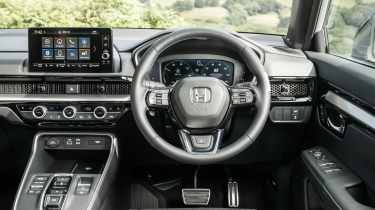
| Pros |
|
| Cons |
|
The sixth-generation Honda CR-V adopts a more modern, dynamic appearance than its predecessor, particularly at the front, thanks to its slim, sharp LED headlights and cleaner bumper and grille designs. Meanwhile, the high-level vertical tail-lights remain similar in form to before, passing on some family resemblance to the newcomer.
The CR-V is very well-equipped in entry-level Elegance trim. It includes:
- A panoramic glass roof
- Electrically adjustable driver's seat
- Heated front seats
- An electric boot lid
- A wireless smartphone charger
- Keyless entry
Step up to the Advance model, and you’ll get an uprated Bose sound system, memory settings for the driver’s seat, ventilated front seats, a head-up display, heated rear seats, and adaptive headlights.
The Advance Tech is the only way to get the plug-in hybrid version, and adds a parking assistance system, black alloy wheels, black exterior trim, and a dark headliner inside.
Interior and dashboard design
Inside, the dashboard layout is nearly identical to that of the latest Honda Civic. In other words, it’s clutter-free, and the main controls (including physical knobs and buttons for the air-conditioning) all sit where you’d expect them to. It’s a refreshingly sensible and user-friendly approach that forgoes the glitzy huge screen and minimalist environment some of its rivals, like the Tesla Model Y have gone for.
Materials and build quality
Everything feels tightly screwed together in the CR-V, and all the buttons, stalks and dials move, click and turn in a highly satisfying manner. However, the whole interior doesn’t quite manage to pull off the trick of feeling like a near £50,000 premium SUV in the same way as an Audi Q5 can. You also don’t have the option of lighter trim colours or material choices to brighten the interior, and with black being your only choice, the CR-V looks quite sombre inside as a result, even with a panoramic glass roof fitted as standard.
Infotainment, sat-nav and stereo
Every version of the CR-V has a nine-inch central touchscreen display, DAB radio, full Apple CarPlay and Android Auto smartphone connectivity, and a sat-nav.
It’s the same screen and software we’ve tried on the latest Civic. We’ve found it to have a logical menu structure, and we welcome maintaining some physical buttons and knobs for controlling frequently used features, such as volume control.
However, it isn’t the most attractive screen display. It looks a little dated next to the Google-based system used in the Volvo XC60, or the OpenR Link system used in the Renault Austral. We also prefer the Google mapping software used in both the Volvo and Renault systems over the CR-V's pre-installed sat-nav system because it’s easier to program and responds really well to voice commands, provided no other noisy people are talking in the back.
The CR-V's standard sound system is okay, but it might be worth opting for the higher-spec Advance model if you regularly drive on the motorway. Its 12-speaker BOSE system has a better chance of drowning out road noise.
“The digital instrument cluster in the CR-V can display sat-nav instructions from third-party navigation software, like Waze, meaning you can use the central infotainment screen for displaying something other than the sat-nav display. It can be a bit laggy in displaying instructions if your phone is running slow, though.” – Max Adams, online reviews editor
Boot space & practicality

| Pros |
|
| Cons |
|
The Honda CR-V is a large SUV, although despite its ample exterior dimensions, it is only available in the UK with five seats because it is offered exclusively as a hybrid. In other markets, you can get a petrol-only version that doesn’t have a battery pack under the boot floor, allowing for a third row of seats to be fitted.
Still, without a pair of seats in the boot, there’s ample space inside for five and their luggage. Those in the back are treated to a reclining back seat to increase comfort on longer trips.
In the front, you get a large central armrest with a sizable storage space underneath. A pair of cup holders is ahead of that, and ahead of the gear selector is the wireless phone charging pad. The door bins and glove box aren’t the largest around. Still, at least the latter isn’t as disappointingly small as what you’ll find in a Peugeot 5008.
Dimensions and size
The latest generation is also the biggest CR-V ever. An extra 106mm in total length frees up 38mm in wheelbase length, meaning there’s an extra 15mm of rear legroom compared with the previous version.
At 4,706mm in length, the CR-V is slightly shorter than the Santa Fe and Sorento. The CR-V is wider than a Peugeot 5008, so it seems a shame that Honda didn’t manage to give this SUV three individual rear seats like the 5008.
| Dimensions | |
| Length | 4,706mm |
| Width | 1,942mm (2,153mm including mirrors) |
| Height | 1,684mm |
| Number of seats | 5 |
| Boot space | 587-1,642-litres (e:HEV), 617-1,710-litres (e:PHEV) |
Seats & passenger space
Those in the front of the Honda CR-V will have plenty of space to stretch out, plus it’s taller than most of its rivals (except for the Hyundai Santa Fe and Kia Sorento), so you get the elevated driving position expected of an SUV. It contributes to the CR-V’s excellent visibility, bolstered further by standard front and rear parking sensors and a reversing camera. Step up to Advance, and you get a 360-degree camera system, while Advance Tech has side parking sensors to help cover all angles.
All versions of the CR-V have electric front seats, so it’ll be easy to find a good driving position. Leg- and shoulder room are plentiful, and the standard panoramic glass roof doesn’t significantly impact head room for taller people.
Rear knee room is impressive for taller passengers, and the rear seatbacks can recline through eight positions to enhance passenger comfort on longer trips. There’s a flat floor and a wide centre seat to make it comfortable for three. It’s a shame you can’t get a more flexible sliding rear bench, as seen in the Audi Q5 and Renault Austral, to vary boot space or leg room, though.
Isofix points are provided for the outer positions of the rear seats. Helpfully, the rear doors open out up to 90 degrees, providing parents or grandparents who need to put children in child seats with much greater access to the back seats. It’s a neat feature also found in the Nissan X-Trail, so we welcome its inclusion on the CR-V.

Boot space
Unlike most plug-in hybrids, the CR-V PHEV has the largest boot in the CR-V range. It’s a healthy 617 litres (635 litres including the storage space below the floor) compared to the hybrid’s 587 litres, and it still has space for the charging cables below the boot floor.
This is because the fuel tank located under the rear seats has been shrunk in the e:PHEV version to 46.5 litres, with the battery utilising the leftover space. The e:HEV hybrid has a bigger 57-litre tank, so the battery pack in this model has to go under the boot floor, taking up valuable space.
The rear seats fold in a 60/40 split, which is average for the class, whereas rivals like the Q5 or BMW X3 offer a far more versatile 40/20/40 layout. Also, there’s a step in the boot floor with the seats down in the e:PHEV version, making it more awkward to slide longer items of flat-pack furniture into the boot.
Towing
Anyone interested in towing must fork out for the priciest Advance Tech PHEV model because that can pull a 1,500kg braked trailer or caravan. The regular e:HEV hybrid can only manage a disappointing 750kg, less than the Hyundai Santa Fe, which can tow up to 1650kg.
“The e:PHEV model may have the greatest towing capacity in the range, but it’s only front-wheel drive, which could make it difficult for anyone trying to tow a caravan across a grass field after it’s been rained on.” – Max Adams, online reviews editor
Reliability & safety

| Pros |
|
| Cons |
|
Safety experts at Euro NCAP have given the Honda CR-V two ratings due to the Sensing 360 safety assistance technology being optional on European models. Without it, the CR-V is a four-star car because of concerns that it may not recognise vulnerable road users in an emergency situation. Cars with it (like all models sold in the UK) get the maximum five-star rating, because the upgraded safety assistance system uses a combined radar and camera-based system that’s better equipped to spot pedestrians and cyclists, and apply countermeasures to either mitigate or avoid a collision with them.
Every version of the CR-V comes with blind spot monitoring to warn you of vehicles approaching from either side, and autonomous emergency braking (AEB) to help prevent or mitigate collisions at low speed with pedestrians, vulnerable road users, or other vehicles. There’s also an eCall to proactively contact the emergency services if the car is involved in a collision where the airbags are deployed, along with a front and rear cross-traffic alert system to warn you of approaching vehicles when attempting to exit a blind junction or merge between parked cars.
In our experience, the Honda Sensing 360 safety technology is fairly hit-and-miss in the CR-V. We found the road sign display spot on, and the 360-degree radar to help prevent collisions with vehicles and pedestrians around town added a welcome safety net, but the multi-view camera system was infuriating.
It includes a camera on the passenger side wing mirror to cover your blind spot, and displays a camera feed when indicating, similar to high-end versions of the Hyundai Santa Fe and Kia Sorento. It isn’t as well-integrated as those rivals, though, because instead of placing the feed in the digital instrument cluster, the CR-V displays it on the central screen, overlaying it on whatever is being shown at the time. This can be a real pain if you're using the sat-nav and need to double-check which exit or junction to take. Thankfully, you can turn off the camera in a sub-menu or by pressing a button on the indicator stalk to cancel the display, although doing so makes this technology seem somewhat redundant.
As mentioned in the previous driving section, it can be a time-consuming process to turn off the speed limit warning, and you can’t just silence the audible part like you can in most cars and retain the visual warning in the instrument cluster. You either have to put up with the audible warning, or switch it all off completely.
According to our 2025 Driver Power owner satisfaction survey, the Honda brand is continuing its rise through the rankings, coming 10th out of 31 manufacturers in the latest survey, up from 11th out of 32 manufacturers in 2024 and 18th out of 32 manufacturers in 2023. Owners rated build quality and running costs above all else, but were less enthusiastic about exterior styling and ride comfort.
| Euro NCAP safety ratings | |
| Euro NCAP safety rating | 4-stars Euro NCAP, 2024 (5-stars with Honda Sensing 360) |
| Adult occupant protection | 85% |
| Child occupant protection | 86% |
| Vulnerable road user protection | 72% (80%) |
| Safety assist | 82% (79%) |
Buying and owning
Best buy: Honda CR-V Elegance 2.0 e:HEV
Unless you have to have a plug-in hybrid for tax purposes, the regular hybrid CR-V provides you with all the performance you’d need for an everyday family car without costing a fortune to run. All versions of the CR-V are well-equipped, so we suggest sticking with the entry-level Elegance, because it offers the best value for money.
Alternatives
Like the ‘90s original, the CR-V still goes up against the Toyota RAV4 – albeit only in plug-in hybrid form until the all-new RAV4 arrives. The UK rival to the CR-V is no longer the Land Rover Freelander, but is currently the Land Rover Discovery Sport.
But there are a whole host of other challengers too, including the Ford Kuga, Hyundai Santa Fe, Kia Sorento, Mazda CX-60, Nissan X-Trail. Peugeot 5008, Renault Austral, and Skoda Kodiaq. The Kodiaq is our favourite in this group because it has a broad range of engine configurations that suit all needs and budgets. The Kodiaq is also available with seven seats, which is no longer an option in the UK for this generation of CR-V.
You can even include posh rivals such as the Audi Q5, BMW X3, Lexus NX and the Volvo XC60 in the mix due to the CR-V's high price. Of the rivals listed, we recommend the NX because it has been our pick for the best mid-size premium SUV for several years, thanks to its low running costs and an extremely well-finished interior.
The price of the CR-V also encroaches on some serious electric vehicle alternatives, such as the best-selling Tesla Model Y. The problem for the CR-V is that while its interior is much easier to get acquainted with, the potential for much lower running costs with the Model Y could prove to be tempting, especially for company car drivers paying BiK tax.
Deals on the Honda CR-V and alternatives
Honda CR-V pictures
Frequently Asked Questions
The Honda CR-V has a fairly standard three-year/90,000-mile warranty, which is less than the five-year/unlimited mileage warranty Hyundai provides, or the up to 10-year/100,000-mile policy from Toyota. You can get an extended warranty of one, two, or three years for your Honda CR-V, with prices ranging from around £450 to £1,000.





